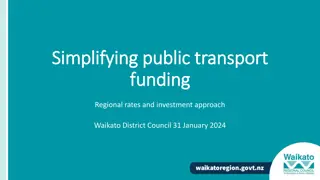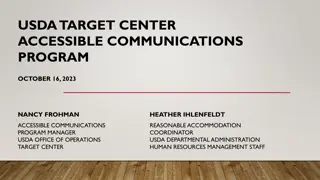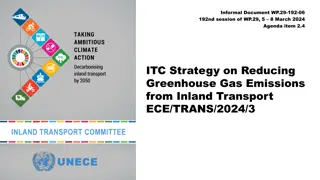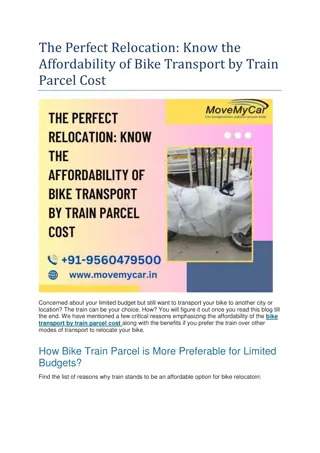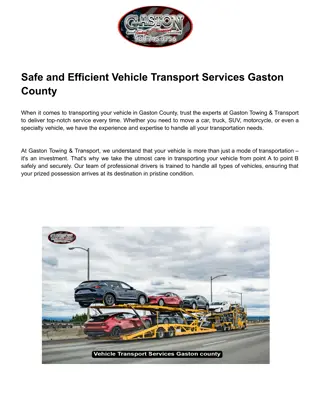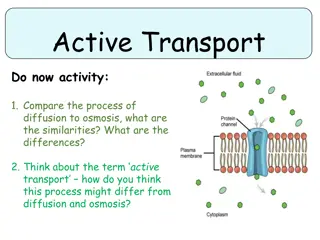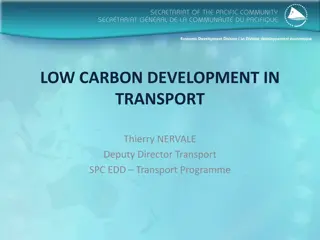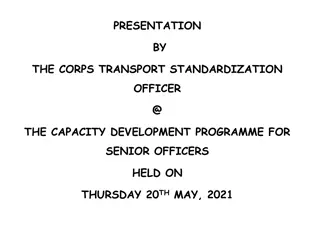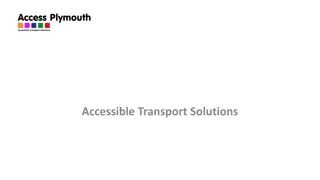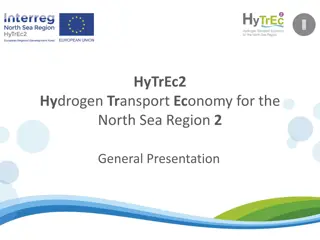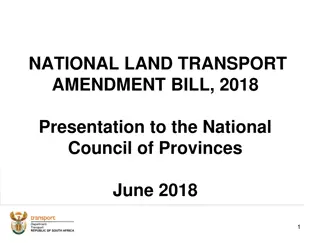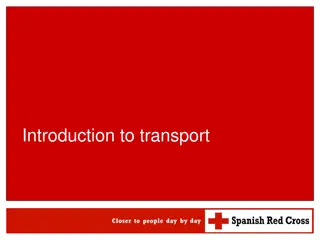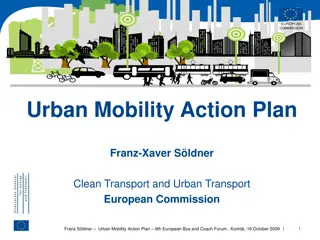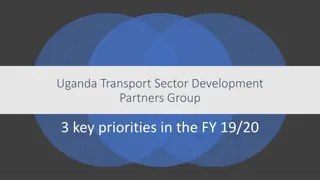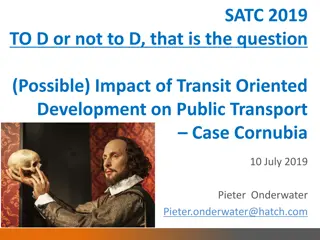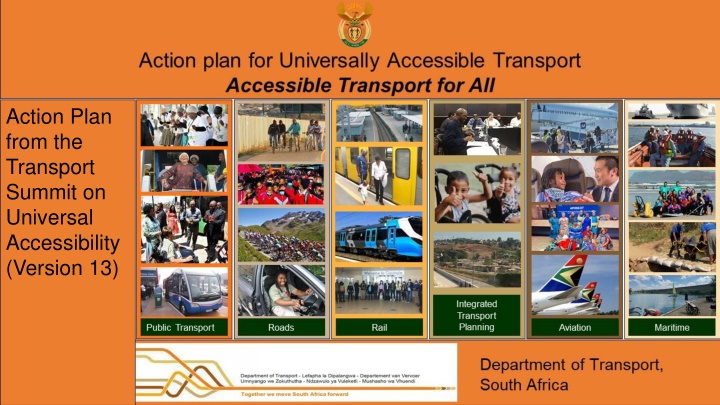
Universal Accessibility Action Plan: Transforming Transportation for All
Enhance universal access in transportation through comprehensive action plans focusing on legislation, policy improvements, service delivery enhancements, and addressing accessibility challenges across various transport sectors.
Download Presentation

Please find below an Image/Link to download the presentation.
The content on the website is provided AS IS for your information and personal use only. It may not be sold, licensed, or shared on other websites without obtaining consent from the author. If you encounter any issues during the download, it is possible that the publisher has removed the file from their server.
You are allowed to download the files provided on this website for personal or commercial use, subject to the condition that they are used lawfully. All files are the property of their respective owners.
The content on the website is provided AS IS for your information and personal use only. It may not be sold, licensed, or shared on other websites without obtaining consent from the author.
E N D
Presentation Transcript
Action Plan from the Transport Summit on Universal Accessibility (Version 13)
Contents Version 13, (Post-Summit, website version) 1. Action Plan: A. Problem Statement B. Guiding framework C. Action plan structure D. Action plan institutional structure E. Priorities and sub-priorities F. Objectives G. Quick wins H. Actions for each transport workstream area 2. References
Problem statement 1. Legislation and policy Public transport licenses, all modes: do not accommodate people with disabilities except IPTN services. No regulations on universally accessible transport for provinces and municipalities under the NLTA. Standards: unimplemented minimum standards leads to inaccessible services, non-compliance is evident. 2. Service delivery Inaccessible transport services: learner, buses, long-distance coaches, On-demand services (dial- a-ride, e-hailing) Minibuses. Most complaints concern minibus taxis. Service strikes: means no accessible services. High cost of transport: long travel distances and no universally accessible vehicles. Inaccessible first and last mile: makes public transport inaccessible. Transport safety: and GBV&F. Inaccessible information: (digital systems, apps and websites). Visual and audio announcements: are not available. No communication with people who are deaf. 1. Legislation and policy White paper on roads policy (2021) has no disability equality focus. Road classification and freight intervention amplifies inaccessibility. Pedestrian crossings: lack of compliance and document alignment: (NTR 1 and the NMT guidelines). 2. Service delivery Lack of connecting pathways and walkways in rural towns and villages. Dangerous roads for people with disabilities and cyclists. Serious injuries and death have been reported. Unacceptable driver behaviour and speeding has caused tragic death and further disablement. Inaccessible commuter and other buses: dangerous to board or replaced with a worse model. Driving licenses, Blue Badges and vehicle modifications for drivers with disabilities: no national system. Other: inaudible electric vehicles, penalization of people with disabilities on mobility scooters, the e-Toll exemption forms are inaccessible. RTMC and SANRAL: support lacking for universal access in committees. 1. Legislation and policy Lack of rail integration: historic planning practices result in stations far from residences. Standards: are not implemented, affecting drop-off, level station platforms, operations & rolling stock. Gautrain: is better, but national standards are also not implemented. 2. Service delivery GBV&F remains an ever-present risk. No access to information and communication: inaccessible systems and no service information. Lack of maintenance and station supervision: lifts and access to platforms breaks down, lighting fails. Lack of reasonable accommodation: it is impossible to complete a journey independently. Station security services: violence against people with disabilities, over- crowding and a direct relationship with GBV&F, insensitive staff. Stations and interchanges: are not accessible. The few improvements are implemented too slowly. Where changes are made, there is no action to remedy non-compliance. Public transport Roads Rail
Problem statement 1. Legislation and policy Legislation and policy is supportive. The lack of an oversight function for complaints, creates a gap in transport integration, negatively affecting all groups of vulnerable transport users, and the number of groups of vulnerable transport users is increasing. Service delivery There is a lack of implementation of universal access in the following areas: E-vehicles: Regulation on electronic vehicles does not accommodate people who are blind because vehicles are inaudible. TETA: no institutionalized capacity building on universal accessibility in transport. BBB-EE: on disability and gender targets are not met in employment, procurement or training across the entire transport family. Freight imbalance causes barriers Urban planning in municipalities negatively effects transport and national urban planning; Nointegrated settlements: is an externality that affects the universally accessible travel chain 1. Legislation and policy Civil Aviation Regulation discrepancies lead to discrimination and court cases. 2. Service delivery Due diligence report not implemented. It covers barriers identified through complaints on booking, disclosing personal information when purchasing tickets, parking, drop off, pick up, ease of movement through the airport, lack of reasonable accommodation during the journey through departures and during the flight, damage to wheelchairs during flight, mistreatment during the use of the passenger aid unit, and abandonment on arrival at an airport or difficult moving with two parents with disabilities form the arrivals exit to the car. Airline bookings and airline services: provide no reasonable accommodation for travelling alone with a disability & there are discrepancies over wheelchair weight Silent airports: were an international trend adopted that was not inclusive. 1. Legislation and policy Maritime legislation, policy and regulation have not been aligned to the Constitution. 2. Service delivery The following service delivery areas fall under Maritime, and some have never dealt with universal accessibility. The others have never critically examined the standards that the use or the service that they give to make sure that it is universally accessible: Inland waterways: these waterways require a license from government to operate with no UA clauses. River crossings: rivers are crossed with inaccessible boats when no bridge is present. Cruises: do not necessarily consider universal accessibility. Sailing and yachting clubs: do not consider universal accessibility as a basic minimum requirement. Tourist destinations: where sea or inland water services are used as a tourist attraction or ferry, for example, Robben Island, accommodation of tourists from countries with higher standards of implemented universal accessibility. Integrated Transport Planning Maritime Aviation
Guiding Framework: universal design in the travel chain 1. Equitable Use 2. Flexibility in Use Give feedback on the trip Plan a Trip 3. Simple and Intuitive Use 4. Perceptible Information 5. Tolerance for Error Get to the destination Get to the pick up point Travel Chain 6. Low Physical Effort 7. Appropriate Size and Get into the vehicle Get out of the vehicle Space for Approach and Use. Make the journey
Action plan: structure The Action Plan includes 6 priority areas that will apply across the transport family, and through which performance will explicitly be measured in the APP. The entire transport family , the Department of Women, Youth, and Persons with Disabilities (DWYPD), and the Department of Performance Monitoring and Evaluation (DPME), shall monitor progress and evaluate successful implementation. These six priorities are: Enabling environment Customer-focused and customer-oriented transport services 1. Priority One: 2. Priority Two: 3. Priority Three: Accessible processes and systems 4. Priority Four: Accessible transport buildings, infrastructure and facilities 5. Priority Five: Accessible vehicles 6. Priority Six: Workplace accessibility and transformation
Action plan: institutional structure EXCO and COTO DOT Universal Access Oversight Committee DoT secretariat Public Transport Roads Rail Aviation Maritime Integrated Public Transport Corporate Services Branch Action Plan Priority Three: Accessible processes and systems Priority One: Enabling environment Priority Two: Customer-focused and customer-oriented transport services Priority Four: Accessible transport buildings, infrastructure and facilities Priority Five: Accessible vehicles Priority Six: Workplace accessibility and transformation
Priorities and sub-priorities Priority Three: a), b), c), Accessible processes and systems Priority One: a), b) c) Enabling environment Priority Two: a), Customer-focused and customer-oriented transport services Priority Four: a) b) Accessible transport buildings, infrastructure and facilities Priority Five: a) Accessible vehicles Priority Six: a) Workplace accessibility and transformation Quick wins Objectives and sub-objectives: 1, 2, 3, 4 Short-term Medium-term Outputs Timeframes Long-term Measures Key Joint projects Status Quick Wins Short term Medium term Long term 2+branches or departments responsible for achievement, as listed Discuss, Underway, for APP, Completed 2025 - 2026 2025 - 2028 2025 2030, (including a pause to review progress) 2030 - 2035
Priorities and sub-priorities examined Priority One: Enabling environment 1.a) Legislation, policy and regulation shall support the universal accessibility of all modes of transport 1.b) Universal accessibility shall be institutionalised across all workstreams 1.c) Capacity development shall increase officials understanding and knowledge of universal design & universal access Priority Two: Customer-focused and customer-oriented transport services 2.a) Persons with disabilities shall have equitable, dignified and responsive access to customer service, and shall be provided with the opportunity to interact and engage, to identify continuous service improvement, and so that barriers are remedied Priority Three: Accessible processes and systems 3.a) Persons with disabilities shall benefit from inclusive and accessible processes and systems: travel chain 3.b) Persons with disabilities shall use innovative technology implemented on an equal basis to others 3.c) Persons with disabilities shall receive responsive and timely information on disruptions, cancellations and major events, and shall be equally accommodated in crises situations & by emergency services Priority Four: Accessible transport buildings, infrastructure and facilities 4.a) Universal design principles and dignified access to transport buildings, infrastructure and facilities shall be planned into and included in all new buildings, expansions, upgrades, retrofits, modifications and maintenance 4.b) Existing infrastructure shall be upgraded or modified to comply with minimum standards (Part S) that support universal design, and reasonable accommodation shall be provided Priority Five: Accessible vehicles 5.a) Persons with disabilities shall have increased access to existing aircraft, vessels, train, bus, coach, midi & minibus taxis, e- hailing/ metered taxis, cars, pedestrian and cycling, and universal access to all future forms of transport Priority Six: Workplace accessibility and transformation 6.a) Inclusive practices for employment of people with disability shall create accessible work environments
Action Plan: Quick wins per workstream Conduct an annual travel survey with the ITP branch, and the ICT subcommittee on UA transport Develop a customer care charter and conditions of carriage for all public transport modes Finalise transversal procurement for buses in IPTN municipalities for Treasury Commence with a new standard (SANS 10370) covering road-based public transport Commence combining NTR 1 as a combined standard with NMT guidelines Commence with selecting & prioritising interventions for station & IPTN service integration Public transport Commence combining NTR 1 as a combined standard with NMT guidelines Commence with a new standard (SANS 10370) covering road-based public transport Identification of vehicle testing centres for drivers with disabilities in each province Finalise the Blue Badge and minimum car parking legislation (completed, with the President) Develop parking guidelines to prevent the misuse of designated car parking bays Introduce a new road safety campaign targeting drivers of vehicles to reduce pedestrian and cyclist fatalities Implement a reasonable accommodation plan for all inaccessible services, including modifying stopping time for boarding and alighting, and providing assistance / temporary modifications where needed Conduct access assessments across the PRASA network to determine reasonable accommodation measures and universal design quick wins Conduct customer care training for all station staff Accelerate the finalisation of the dedicated maintenance budget for station access improvements, particularly for lifts and platforms Fast-track acquisition and installation of suitable signage Commence with selecting & prioritising interventions for station & IPTN service integration Roads Rail
Action Plan: Quick wins Establish an institutional structure for universal accessibility in all workstreams Conduct a travel survey on accessible transport with the Public Transport Branch Commence the process of institutionalising the complaints system through the economic regulator Alignment of ITSB-BBEE Codes to DTIC Codes of Good Practice Develop a bid specification on disability awareness raising programme for the entire transport family Conduct a gap analysis of universal design and universal access modules in all academic funded transport programmes, and TETA training programmes ITP/COO Implement an ACSA and Ekurhuleni municipality Airport Terminal Bus stop project Set up help desks at all airports, providing free porter assistance (reasonable accommodation) to all passengers using airport premises Institutionalise the ACSA Access committee Implement air and ground staff oversight and monitoring of complaints handling for passengers with disabilities at all airports Implement guidelines for airlines on booking flights for persons with disabilities and monitor standards Aviation Conduct travel chain and accessibility audits for Inland Waters/ Dams pilot projects with selected municipalities Conduct travel chain and accessibility audits of all ports, inclusive of infrastructure and operations Conduct travel chain and accessibility audits of inland waterways, beach facilities and ports Maritime
What will each workstream deliver?: Priorities 1-3 P R I O R I T Y services and facilities transport & vehicles Public Transport Roads Rail ITP / COO Aviation Maritime Accessible public transport vehicles, Accessible driving and testing, non- motorised Accessible rail rolling stock, services and facilities Accessible transport planning, coordination and development Accessible booking procedures, airports, operations and aircraft Accessible services on inland water, ports and beaches 1 Review and revision of legislation Regular engagement with universal access passengers Institutional structures supporting universal design and universal access Reporting procedures within DoT to the Regulator and to DWYPD Disability awareness and capacity development 2 Passenger travel survey focused on universal accessibility issues Transformed customer services in public transport Complaints escalation process Service-specific reasonable accommodation Development of the regulator to oversee complaints in line with Transport legislation Coordination of access audits across the travel chain Research into technology to assist with information and communication Coordination of reporting on procedures for emergencies and disruptions in all forms of transport Passenger travel survey focused on universal accessibility issues Transformed customer services in public transport Complaints escalation process Service-specific reasonable accommodation 3 Access audits across the travel chain Technology to assist with information and communication Implement mode-specific reasonable accommodation solutions Procedures for emergencies and disruptions in all forms of land transport Access audits across the travel chain Technology to assist with information and communication Implement mode-specific reasonable accommodation solutions Procedures for emergencies and disruptions in all forms of aviation and maritime services 12
What will each workstream deliver?: Priorities 4-6 YPublic Transport Roads Rail ITP / COO Aviation Maritime P R I O R I T Accessible public transport vehicles, services & facilities Accessible driving and testing, non- motorised transport & vehicles Accessible rail rolling stock, services and facilities Accessible transport planning, coordination & development Accessible booking procedures, airports, operations & aircraft Accessible services on inland water, ports and beaches 4 Accessible public transport infrastructure and crossings Accessible planning guidelines, intermodal facilities, integrated & accessible interchanges compliant with Part S Guidelines for upgrading accessible existing building compliant with Part S Maintenance-management guidelines supporting compliance with Part S Accessible aviation and maritime infrastructure Accessible new buildings compliant with Part S Accessible new buildings compliant with Part S Accessible existing building compliant with Part S Accessible existing building compliant with Part S Maintenance management programme supporting compliance with Part S Maintenance management programme supporting compliance with Part S Integrated and accessible transport interchanges Integrated and accessible transport interchanges 5 Accessible road-based public transport vehicles: new standards Timetable for phasing in accessible vehicles/rolling stock, & phasing out inaccessible vehicles/rolling stock Research into universally accessible vehicles Accessible planes and airport vehicles: new standards Phasing in accessible vehicles Phasing in accessible vehicles Phasing out in-accessible vehicles Phasing out in-accessible vehicles 6 Accessible workplaces and practices in all forms of public transport Alignment of BB-EEE codes and managerial training Revised reporting procedures 13 Revised mentoring and training for supervisors and managers
Priority 1 Priority 3 Priority 5 Implementation programme: 2025-35 Priority 6 Priority 2 Priority 4 2025 2028 2030 2035 Long Term Medium Term Policy and legislation Short Term Timeframes Quick wins Infrastructure and vehicles Reasonable accommodation Public Transport 1 5 5 1 3 2 4 4 1 3 4 4 5 4 3 6 6 5 2 5 3 Roads 6 2 4 3 4 4 3 3 4 5 2 4 1 1 6 5 3 5 5 5 1 3 4 4 1 5 6 6 4 3 1 3 3 4 3 5 5 2 4 2 4 Rail 2 3 1 5 5 1 6 1 4 2 3 1 6 6 4 6 4 ITP / COO Aviation 3 4 1 1 3 5 5 3 2 3 6 6 4 4 1 2 3 3 5 6 Maritime 6 1 1 3 1 5 3 3 2 4 2 3 4 3 3 4
Summary of Actions (Version 12)
Priority One: Enabling environment Priority one Enabling environment Priority 1.a) Legislation, policy and regulation shall support the universal accessibility of all modes of transport Objective 1 1.1 Modal Workstreams A modal legislative service delivery review shall be conducted against universal accessibility requirements (Workstreams shall carry out a modal service delivery review of modal transport acts, regulations, policies, procedures, standards, & practices) 1.2 ITP ITP shall oversee, collate and publish all reviews of modal service delivery legislative reviews Objective 2 A consistent approach to transport universal accessibility shall be promoted across all workstreams Priority 1.b) Universal accessibility shall be institutionalised across all workstreams Objective 1 Transport shall hold regular and on-going engagements with universal access user groups in all workstreams Objective 2 Compliant reporting on universal accessibility shall be introduced Objective 3 A complaints management process and transport accessibility oversight shall be established Priority 1.c) Capacity development shall increase officials understanding and knowledge of universal design & universal access Objective 1 Disability awareness training for all modal workstreams, shall be conducted with the application of the travel chain to all forms of transport Objective 2 Standardised UD&A module shall be developed within all transport academic courses and training programmes
1.a) Priority 1 1.a) Objective 1 1.a) 1.1 Objective 1 A modal legislative service delivery review shall be conducted against universal accessibility requirements Enabling environment Legislation, policy and regulation shall support the universal accessibility of all modes of transport Activities Outcome Review legislation and produce a gap analysis on legislation that prohibits universal accessibility gaps in legislation prohibits universal access, & that which promotes it accessibility as part of on-going actions Review all contracts, concessions, licenses and another legal agreements for conditions on universal access equality & prevent unfair discrimination Develop plan to bring in new standards and regulations on universal design, universal access and reasonable accommodation in the travel chain in the long-term Complete finalisation & gazette the combined minimum standard on NTR 1 & the NMT guidelines expectation & experience of universally accessible transport across local, provincial, national & international transport Amend NRTA (driving with a disability: provision in testing centres) Oversee reports on the submission of the reviews per workstream review process Measure Number of modal reports reviewing UA in service delivery policy and legislation, including gaps, standards and regulations for ITP to collate Review of all contracts, concessions, licenses and another legal agreements for conditions on universal accessibility, & newly published revised ones Timeframe Agency Medium- term (2025- 2030) A comprehensive understanding of DoT modal work- streams Workstreams shall carry out a modal service delivery review of modal transport acts, regulations, policies, procedures, standards, & practices against national standards on universal access and international practice, and coordinate with ITP on the publication of a gap analysis Identify standards and regulations that require revision to include universal New processes in all modes that promote Consistency of passenger Gazetted minimum standard on NTR 1 & the NMT guidelines A completed new bus standard, (SANS 10370) Public Transport/ Roads Complete finalisation of new bus standards, and new vehicle standards for drivers with disabilities (SANS 10370) Amend NRTA (parking) NRTA Amendment (parking) NRTA amendment (Testing centres) Published review on universal access gaps in transport legislation Roads Roads 1.a) 1.2 ITP shall oversee, collate and publish all reviews of modal service delivery legislative reviews Collated legislative ITP/ COO
1.a) Priority 1 1.a) Objective 1 (cont d) A modal legislative service delivery review shall be conducted against universal accessibility requirements (Workstreams shall carry out a modal service delivery review of modal transport acts, regulations, policies, procedures, standards, & practices) Objective 1 A modal legislative service delivery review shall be conducted against universal accessibility requirements (cont d) Enabling environment Legislation, policy and regulation shall support the universal accessibility of all modes of transport Activities Outcome Measure Timeframe Agency Introduce new standards and regulations per mode on universal design, universal access and reasonable accommodation in the travel chain Develop universal access regulations based on developed standards, with implementation timeframes Bring in regulations on UA under Chapter 1, Section 8(1)(y) & other parts of the NLTA Update Road Traffic Signs Manual with UA standards Amend Rolling Stock standards so that all new rolling stock is universally designed Develop guidelines and planning principles on integration of rail with public transport Develop new rail and IT-related standards Review and develop CAA regulations (Part 121: 91 &135.07.36 & 139),) in line with Constitutional equality clause Review and improve standards for Passenger Aid Unit Services, handling agents / IOSA Bring in new CAA regulations, airport and PAU standards Review the CMTP & amend the National Ports Act, 2005 to incorporate universal design & access design principles Publish UA standards for ports, cruise liners, day trip boats and ferries Bring in new NLTA regulation and standards for maritime infrastructure Provide oversight & direction on compliance through the Public Transport Regulator. Amend the NLTA to provide the necessary powers New standards that promote equality & prevent unfair discrimination New regulations and standards published, including but not limited to those specifically mentioned DoT Modal work- streams Long-term (2030-2035) Consistency of passenger expectation & experience of universally accessible transport across local, provincial, national and international transport P.T, Rail & Roads Roads Rail Rail /ITP Rail Aviation Maritime ITP/ COO Collated legislative review process
1.a) Priority 1 1.a) Objective 2 A consistent approach to transport universal accessibility shall be promoted across all workstreams Objective 2 A consistent approach to transport universal accessibility shall be promoted across all workstreams Enabling environment Legislation, policy and regulation shall support the universal accessibility of all modes of transport Activities Review and measure current policies, procedures & practices against existing standards and international practice to produce modal codes of practice Bring in new processes on universal design, universal access and reasonable accommodation in the travel chain Develop plan to bring in new standards and regulations on universal design, universal access and reasonable accommodation in the travel chain in the long-term Develop a transport-wide Universal Access Strategy based on the Departmental-wide legislative review (see next slide) Outcome Consistent approach to implementing universal accessibility regardless of modes of transport applied by the Department of Transport, SoEs, Provinces and Municipalities Measure Published code of practice per mode Timeframe Medium- Term (2025-2030) Agency DoT modal work- streams Plan developed for new standards and regulations per mode Published Transport- wide Universal Access Strategy Published Standard Operating Procedure (SOP) on infrastructure (Part S) ITP/ COO Prepare an template for an infrastructure SOP covering the following: New transport buildings, infrastructure and facilities shall comply with minimum standards on Part S and will be examined using an access audit prior to handover. The contract will include a clause on remedial action to be required before project completion Produce detailed universal access guidelines and minimum requirements under the National Land Transport Strategic Framework (NLTSF), reviewing sector-specific interventions for IPTN integrated transport planning Carry out Due Diligence audits per mode that cross-check issues raised in concessions and contracts with complaints to identify administrative barriers to universal access (including cross-boarder) DoT modal work- streams Published NLTSF universal access guidelines and minimum requirements Completed Due Diligence Audits Compliance report on UA published ITP/ COO ITP/ COO
1.a) Priority 1 1.a) Objective 2 (cont d) Activities A consistent approach to transport universal accessibility shall be promoted across all workstreams Objective 2 A consistent approach to transport universal accessibility shall be promoted across all workstreams (cont d) Enabling environment Legislation, policy and regulation shall support the universal accessibility of all modes of transport Outcome Conduct pilot projects per mode on licenses with conditions on UA, and reasonable accommodation, expand to cover all services. Include coach, minibus, tourism, and e-hailing as well as all regular scheduled bus services regardless of modes of transport Conduct pilot projects with driving licenses for testing centres, expand to designated licenses centres Review reasonable accommodation and testing centre licenses Review all public private, local and long-distance rail services including Shosholoza Meyl, reasonable accommodation pilot programmes and licenses Review public and private airports and airlines, expand to cover all public and privately run airports Measure Number of Public Transport pilot projects, reviewed, expanded and embedded, including reasonable accommodation Number of Roads pilot projects, reviewed, expanded and embedded, including reasonable accommodation Timeframe Medium- term (2025- 2030) Agency PT Consistent approach to implementing universal accessibility Roads Number of Rail pilot projects, reviewed, expanded and embedded, including reasonable accommodation Number of Aviation pilot projects, reviewed, expanded and embedded, including reasonable accommodation Number of Maritime pilot projects, reviewed, expanded and embedded, including reasonable accommodation Transport-wide Universal Access Strategy published Rail Aviation Conduct pilot projects with selected yacht clubs, sea-related services, and services that operate on inland waterways and ports. Expand to cover all services Use reviews to develop a Transport-wide Universal Access Strategy Maritime ITP /COO
Outputs and timeframes Enabling environment: mode specific interventions Legislation, policy and regulation shall support the universal accessibility of all modes of transport Public Transport Roads Modal reports reviewing UA in service delivery policy and legislation, including gaps, standards and regulations for ITP to collate Review of all contracts, concessions, licenses and another legal agreements for conditions on universal accessibility, & newly published revised ones New bus standard Gazetted minimum requirements on NTR 1 and NMT guidelines ITP shall oversee, collate and publish all reviews of modal service delivery legislative reviews NRTA amendment (Testing centres) A consistent approach to transport universal accessibility shall be promoted across all workstreams Due Diligence Audits per mode Pilot projects per workstream, reviewed, expanded and embedded, including reasonable accommodation A Transport-wide Universal Access Strategy Timeframe Medium-term (2025-2030) 1 A modal legislative service delivery review shall be conducted against UA requirements other parts of the NLTA, with Roads standards integration Priority 1.a) 1. 1.a) Objective 1 A modal legislative service delivery review shall be conducted against universal accessibility requirements Rail Aviation ITP Maritime Published review on universal access gaps in transport legislation Completed Due Diligence Audits Compliance report on UA published A completed new bus standard, (SANS 10370) NRTA Amendment (parking) Codes of practice on universally accessible services per mode A plan on new standards and regulations per mode A Standard Operating Procedure (SOP) on infrastructure (Part S) NLTSF universal access guidelines and minimum requirements 2 Regulations on UA under Chapter 1, Section 8(1)(y) & Updated Road Traffic Signs Manual with UA Guidelines & planning principles on rail /PT Compliance through the Public Transport Regulator. Amended NLTA to provide the necessary powers Reviewed & improved CAA regulations, standards for PAU Services Reviewed & amended CMTP & NPA, NLTA incorporating UDA, principles, standards & regulations for ports, cruise liners, daytrip boats, ferries & infrastructure Timeframe Long-term (2030-2035)
1.b) Priority 1 1.b) Objective 1 Transport shall hold regular and on-going engagements with universal access user groups in all workstreams Objective 1 Transport shall hold regular and on-going engagements with universal access user groups in all workstreams Enabling environment Universal accessibility shall be institutionalised across all workstreams Activities Outcome Institutionalise the ACSA Access forum, PRASA Access committee, and others as required sectors so that remedial action becomes part of everyday practice, and not reliant on court cases access oversight committee and modal workstream reporting, established under priority 2.a) Objective 2 Coordinate and provide the administrative support for quarterly engagements with the ICT subcommittee on universally accessible transport, workstreams and industry Conduct an annual travel survey with the PT branch, and the ICT subcommittee on universally accessible transport a longitudinal survey, of the effectiveness of the implementation of transport policy, from users Measure Meetings held, agenda and minutes, attendance registers if available Timeframe Short-term (2025-2028) Agency DoT modal work- streams ITP /COO Better liaison with the disability and access Develop an institutional structure with an Access Oversight Committee under ITP, liaising with each workstream Develop the terms of reference for a universal Terms of reference for UA oversight committee produced ITP /COO Meetings held, agenda and minutes, attendance registers if available PT/ ITP Develop a better understanding through Annual travel survey produced PT/ ITP
1.b) Priority 1 1.b) Objective 2 Compliant reporting on universal accessibility shall be introduced Objective 2 Compliant reporting on universal accessibility shall be introduced Enabling environment Universal accessibility shall be institutionalised across all workstreams Activities Designate officials per branch and requirements as part of KPIs for reporting on the WPRPD. The WPRPD report shall be completed by each mode, collated by ITP and submitted to DWYPD Reporting framework for WPRPD circulated by ITP to modal workstreams, through the DG's office, report to DWYPD Outcome Reporting across the entire transport family to the DWYPD on the WPRPD Measure Complete WPRPD reports submitted annually to ITP dealing with all UA issues per workstream Timeframe Short-term (2025-2028) Agency DoT modal work- streams Reporting framework developed. Reports submitted annually to DWYPD ITP /COO
1.b) Priority 1 1.b) Objective 3 A complaints management process and transport accessibility oversight shall be established Objective 3 A complaints management process and transport accessibility oversight shall be established Enabling environment Universal accessibility shall be institutionalised across all workstreams Activities Outcome Develop an institutional structure with an Access Oversight Committee under ITP, liaising with each workstream legislative requirements A passenger complaints management process for all universal access passengers using all modes, under the Economic Transport Regulator; with a complaints desk The role of the Economic Transport Regulator in dealing with disability and universal access issues, to be established using existing legislation and new legislation if required Monitor remedial action taken and record information from complaints reported from each workstream Prepare complaint reports under the Economic Transport Regulator, for the DWYPD annually, and the parliamentary portfolio committee as required Prepare a registry of remedial action taken under the Transport regulator Measure Meetings held, agenda and minutes, attendance registers if available Passenger complaints are correctly recorded and included in WPRPD reports Remedial action is recorded over time Timeframe Medium- term (2025- 2030) Agency ITP /COO with Modal work- streams Remedial action on complaints in line with Annual reports are submitted to the Economic Transport Regulator A registry of remedial Action is developed ITP /COO
Outputs and timeframes 1.b) 1. 1.b) Objective 1 Enabling environment Universal accessibility shall be institutionalised across all workstreams Public Transport Roads Transport shall hold regular and on-going engagements with universal access user groups in all workstreams survey Compliant reporting on universal accessibility shall be introduced issues per mode Timeframe Short-term (2025-2028) 3 A complaints management process and transport accessibility oversight shall be established Aviation Quarterly meetings with user groups, agenda and minutes, attendance registers Rail Quarterly meetings with user groups, agenda and minutes, attendance registers ITP Terms of reference for UA oversight committee produced Quarterly meetings held, with ICT subcommittee, agenda & minutes, attendance registers Annual travel survey Reporting framework developed for WPRPD Reports submitted annually to DWYPD on the WPRPD Maritime Quarterly meetings with user groups, agenda and minutes, attendance registers Quarterly meetings with user groups, agenda and minutes, attendance registers Annual travel Quarterly meetings with user groups, agenda and minutes, attendance registers Complete WPRPD reports submitted annually to ITP dealing with all UA Public Transport Complete WPRPD reports submitted annually to ITP dealing with all UA Roads issues Complete WPRPD reports submitted annually to ITP dealing with all UA Rail issues Complete WPRPD reports submitted annually to ITP dealing with all UA Aviation issues Complete WPRPD reports submitted annually to ITP dealing with all UA Maritime issues 2 Correctly recorded passenger complaints Correctly recorded passenger complaints Correctly recorded passenger complaints Passenger complaints are included in WPRPD reports Remedial action is recorded over time Annual reports are submitted to the Economic Transport Regulator A registry of remedial Action is developed Correctly recorded passenger complaints Correctly recorded passenger complaints Timeframe Medium-term (2025-2030)
Disability awareness training for all modal workstreams, shall be conducted with the application of the travel chain to all forms of transport Enabling environment 1.c) Objective 1 Priority 1 1.c) Objective 1 Disability awareness training for all modal workstreams, shall be conducted with the application of the travel chain to all forms of transport Capacity development shall increase officials understanding and knowledge of universal design & universal access Activities Develop a general disability and universal access awareness module(s) for transport with TETA Outcome (A) disability awareness module(s) available for and used by the entire transport family Measure Meetings held, agenda and minutes, attendance registers if available, and resultant disability awareness module(s) Number of staff in the transport family trained in Disability awareness. Timeframe Short-term (2025-2028) Agency ITP /COO/ TETA / DoT modal work- streams Implement a disability and universal access awareness module, based on the general module for all modal staff across all workstreams, including all SoEs, Departments of Transport in Provincial & municipal government, with TETA ITP /COO/ TETA / DoT modal work- streams Medium- term (2025- 2030)
1.c) Priority 1 1.c) Objective 2 Standardised UD&A module shall be developed within all transport academic courses and training programmes Objective 2 Standardised UD&A module shall be developed within all transport academic courses and training programmes Enabling environment Capacity development shall increase officials understanding and knowledge of universal design & universal access Activities Review current and develop knowledge programmes with TETA in universal design and universal access for: Public Transport, Roads, Rail, Integrated Transport Planning, Aviation and Maritime Outcome Universal access knowledge programmes and products for transport available to everyone involved in delivering services to universal access passengers or employing people with disabilities Measure Number of published review and knowledge programmes and products for all modal workstreams Numbers of sponsored universities with UA courses included in programmes Number of Public Transport/ Roads / Rail /Aviation /Maritime workstream staff attending courses on universal accessibility in transport Timeframe Short-term (2025- 2028) Agency ITP /COO/ TETA / DoT modal work- streams Introduce knowledge products in universal design and universal access into university programmes for Public Transport, Roads, Rail, Integrated Transport Planning, Aviation and Maritime Planners and operations managers, drivers and facilities staff regularly trained on universal design, access and reasonable accommodation for Public Transport services Roads engineers, facilities and security staff regularly trained on universal design, access and reasonable accommodation in service stations and car parks Planners and operations managers, drivers and facilities staff regularly trained on universal design, access and reasonable accommodation for Rail services Planners and operations managers, land and air side (cabin crew) and facilities staff regularly trained on universal design, access and reasonable accommodation for Aviation services Planners and operations managers, land and water-side (cabin crew) and facilities staff regularly trained on universal design, access and reasonable accommodation for Maritime services ITP /COO/ TETA / DoT modal work- streams P.T Medium- term (2025- 2030) Roads Rail Aviation Maritime
1.c) Priority 1 1. c) Capacity development shall increase officials understanding and knowledge of universal design & universal access Objective Public Transport Roads 1 Disability awareness training for all modal workstreams, shall be conducted with the application of the travel chain to all forms of transport programmes & products for all Public Transport developed within all transport academic courses and training programmes Timeframe Short-term (2025-2028) 1 Disability awareness training for all modal workstreams, shall be conducted with the application of the travel chain to all forms of transport 2 Standardised UD&A module shall be developed within all transport academic courses and training programmes transport included in academic courses for the Public Transport workstream Outputs and timeframes Enabling environment Aviation Attend ITP meetings Published review and knowledge programmes and products for Aviation Rail Attend ITP meetings Published review and knowledge programmes and products for Rail ITP Agenda and minutes, attendance registers if available, for meetings held. Maritime Attend ITP meetings Published review and knowledge programmes and products for Maritime Attend ITP meetings Published review & knowledge Attend ITP meetings Published review and knowledge programmes and products for Roads Disability awareness module(s) reviewed and developed 2 Standardised UD&A module shall be Disability awareness training for staff in Public Transport Disability awareness training for staff in Roads Disability awareness training for staff in Rail Disability awareness training for staff in ITP/ COO Disability awareness training for staff in Aviation Disability awareness training for staff in Maritime Module on universal accessibility in Module on universal accessibility in transport included in academic courses for the Roads workstream Module on universal accessibility in transport included in academic courses for the Rail workstream Universities with UA courses included in programmes Module on universal accessibility in transport included in academic courses for the ITP/ COO workstream Module on universal accessibility in transport included in academic courses for the Aviation workstream Module on universal accessibility in transport included in academic courses for the Maritime workstream Timeframe Medium-term (2025-2030)
Priority Two: Customer-focused and customer- oriented transport services Priority 2 Customer-focused and customer-oriented transport services Priority 2.a) Persons with disabilities shall have equitable, dignified and responsive access to customer service, and shall be provided with the opportunity to interact and engage, to identify continuous service improvement, and so that barriers are remedied Objective 1 Equitable, dignified and responsive access to customer service shall be promoted Objective 2 Modal workstreams shall promote of passenger rights through escalation Objective 3 All modes shall address their responsibilities on the care & reasonable accommodation of universal access passengers
2.a) Priority 2 Objective 1 Equitable, dignified and responsive access to customer service shall be promoted Customer-focused and customer-oriented transport services Persons with disabilities shall have equitable, dignified and responsive access to customer service, and shall be provided with the opportunity to interact and engage, to identify continuous service improvement, and so that barriers are remedied Activities Outcome Develop input for the strategy and passenger charter on universally accessible transport for all modes of transport in all transport modes regardless of workstream, dealing with transport barriers systematically 2.a) Objective 1 Equitable, dignified and responsive access to customer service shall be promoted Measure Strategy and passenger charter published for Public Transport, Rail and Aviation published Number of customer service contracts for each mode that include universal design, universal access and reasonable accommodation for passenger-related services Strategy and passenger charter published for Maritime and Roads published Input on strategy and passenger charter covering all forms of transport Timeframe Short-term (2025- 2028) Agency Public Transport, Rail, Aviation Responsive customer care Include universal design and universal access and reasonable accommodation as part of all customer service contracts across each modal travel chain for passenger-related services DoT modal workstreams Medium- term (2025- 2030) Develop input for the strategy and passenger charter on universally accessible transport for all modes of transport Maritime, Roads Develop strategy and passenger charter on universally accessible transport, focusing on helpful and friendly staff, and a functioning customer service system at operator and governmental level Develop a strategy and charter on universally accessible transport covering all transport modes, outlining ITP oversight role DoT modal workstreams ITP /COO Strategy and passenger charter published covering all forms of transport, including ITP oversight role
2.a) Priority 2 Objective 2 Modal workstreams shall promote of passenger rights through escalation Customer-focused and customer-oriented transport services Persons with disabilities shall have equitable, dignified and responsive access to customer service, and shall be provided with the opportunity to interact and engage, to identify continuous service improvement, and so that barriers are remedied Activities Outcome Report through the universal access oversight committee oversight structure established under priority 1.b) Objective 1 barriers systematically collected within DoT, and remedial action taken SoEs/ municipality and collect feedback in support of service experience 2.a) Objective 2 Modal workstreams shall promote of passenger rights through escalation Measure Regular reports from each workstream to the universal access oversight committee Number of operational checks and reports on operations by each workstream on universal accessibility Number of Provincial universal access groups or other structures running and supported Timeframe Short-term (2025- 2028) Agency DoT modal workstreams Effective reporting of Monitor transport service customer interface, and implement contractual conditions Medium- term (2025- 2030) Set up a universal access user group in the provinces/
2.a) Priority 2 Objective 3 All modes shall address their responsibilities on the care & reasonable accommodation of universal access passengers Customer-focused and customer-oriented transport services Persons with disabilities shall have equitable, dignified and responsive access to customer service, and shall be provided with the opportunity to interact and engage, to identify continuous service improvement, and so that barriers are remedied Activities Outcome Implement a safe transport campaign, that includes safer driving creation of barriers in transport for people with disabilities and other universal access passengers Identify the need for particular campaigns from complaints and coordinate their implementation 2.a) Objective 3 All modes shall address their responsibilities on the care & reasonable accommodation of universal access passengers Measure Evidence of implementation of a safe transport and safe driving campaign Number of UA awareness campaigns implemented in different modes Evidence that complaints / passenger input have led to safe transport campaigns Timeframe Short-term (2025- 2028) Agency DoT modal workstreams Prevention of the Through the safe driving campaign protect pedestrians, cyclists and vulnerable road users Develop awareness campaigns to run in parallel to the passenger charter, on the right of access to transport in each mode in each workstream Medium- term (2025- 2030) ITP /COO
2.a) Priority 2 Outputs and timeframes Customer-focused and customer-oriented transport services Persons with disabilities shall have equitable, dignified and responsive access to customer service, and shall be provided with the opportunity to interact and engage, to identify continuous service improvement, and so that barriers are remedied Objective Public Transport Roads 1 Equitable, dignified and responsive access to customer service shall be promoted passenger charter 2 Modal workstreams shall promote of passenger rights through escalation 3 All modes shall address their responsibilities on the care & reasonable accommodation of universal access passengers Timeframe Short-term (2025-2028) 1 Equitable, dignified and responsive access to customer service shall be promoted 2.a) Aviation Strategy & passenger charter Rail Strategy & passenger charter ITP Maritime Strategy & Reports from each workstream submitted to the universal access oversight committee Implementation programmes that are part of a safe transport and safe driving campaign Strategy & passenger charter Strategy & passenger charter published covering all forms of transport, including ITP oversight role Strategy & passenger charter Customer service contracts for each mode that include universal design, universal access and reasonable accommodation for passenger-related services Input on strategy and passenger charter covering all forms of transport Operational checks and reports on operations by each workstream on universal accessibility Provincial universal access groups or other structures running and supported Universal accessibility awareness campaigns implemented in different modes Direct use of complaints / passenger input leading to safe transport campaigns 2 Modal workstreams shall promote of passenger rights through escalation All modes shall address their responsibilities on the care & reasonable accommodation of universal access passengers Timeframe 3 Medium-term (2025-2030)
Priority Three: Accessible processes and systems Priority 3 Accessible processes and systems Priority 3.a) Persons with disabilities shall benefit from inclusive and accessible processes and systems: travel chain Objective 1 Services shall overtime, ensure that reasonable accommodation is in place through out the travel chain, including safety and security Objective 2 Modal and sector-specific solutions shall be implemented: All modes shall address their responsibilities on the care & reasonable accommodation of universal access passengers Objective 3 Long-term solutions to barriers shall be identified and implemented Priority 3.b) Persons with disabilities shall use innovative technology implemented on an equal basis to others Objective 1 Information and communication audits conducted on all modes and services in each workstream: Persons with disabilities shall use innovative technology implemented on an equal basis to others Objective 2 Improve passenger experience through universally designed innovative technology Priority 3.c) Persons with disabilities shall receive responsive and timely information on disruptions, cancellations and major events, and shall be equally accommodated in crises situations & by emergency services Objective 1 Emergency service responses shall be aligned to emergency situations per mode inclusive of people with disabilities and other vulnerable groups
3.a) Objective 1 Services shall overtime, ensure that reasonable accommodation is in place through out the travel chain, including safety and security Customer-focused and customer-oriented transport services Persons with disabilities shall benefit from inclusive and accessible processes and systems: travel chain Priority 3 3.a) Objective 1 Services shall overtime, ensure that reasonable accommodation is in place through out the travel chain, including safety and security Activities Conduct universal access audits, including interviews with people with disabilities and other UA passengers; on all modes of transport in all workstreams Barriers identified and a programme for reasonable accommodation measures put in place, long term barriers recorded Development of a universal design access plan (UDAP) UDAP by every transport mode in all workstreams workstream Review and audit cross-border travel chain barriers affecting road, rail, public transport, and ports Research and examine city planning to introduce guidelines and principles for safer cities, towns and villages Outcome Audits for compliance with WPRPD and to improve public safety, equality and dignity in transport environments Measure Number of universal access audits conducted per mode Implementation plan in place and regularly updated, per mode Number of complete and up-to-date UDAPs per workstream Number of cross- boarder reviews Safe city research study completed with guidelines and principles Timeframe Short-term (2025- 2028) Agency DoT modal workstreams Medium- term (2025- 2030) ITP /COO
3.a) Objective 2 Modal and sector-specific solutions shall be implemented: From sector-specific barriers, implement projects not limited to but including the following: Customer-focused and customer-oriented transport services Persons with disabilities shall benefit from inclusive and accessible processes and systems: travel chain Priority 3 3.a) Objective 2 Modal and sector- specific solutions shall be implemented: From sector- specific barriers, implement projects not limited to but including the following: Activities Process for blue badges and dedicated car parking regulated and managed effectively by government Outcome Implementation of high priority, easy to implement mode specific interventions for people with disabilities and other universal access passengers Measure Number of provinces with effective process for blue badges Number of provinces with testing centre(s) for drivers with disabilities Number of airlines trained on booking guidelines Process for monitoring and oversight of air and ground complaints from people with disabilities Number of manned helpdesks and reasonable accommodation measures in place Reports on process for reserving seats and provision of assistance tested by people with disabilities Reports on process for reserving seats and provision of assistance tested by people with disabilities Timeframe Short-term (2025- 2028) Agency Roads Ensure that there vehicle testing centres for drivers with disabilities in each province, with suitably trained staff Implement guidelines for airlines on booking flights for persons with disabilities and monitor standards Implement air and ground staff oversight and monitoring of complaints handling for passengers with disabilities at all airports Aviation Set up help desks at all airports, providing free porter assistance (reasonable accommodation) to all passengers using airport premises Reserved seats and operating procedures for people with disabilities and others requiring special assistance at the boarding gate and on the plane Reserved seats and operating procedures for people with disabilities, and others requiring special assistance when boarding any maritime service Maritime
3.a) Objective 2 Modal and sector-specific solutions shall be implemented. From sector-specific barriers, implement projects not limited to but including the following Customer-focused and customer-oriented transport services Persons with disabilities shall benefit from inclusive and accessible processes and systems: travel chain Priority 3 3.a) Objective 2 (cont d) Modal and sector- specific solutions shall be implemented. From sector-specific barriers, implement projects not limited to but including the following: Activities Pilot and implement the sign language and assistive technology policy in all modal services, and provide feedback Establish a task team for e-hailing and on-demand services established to encourage innovative solutions for first and last mile transport, transport hub integration and learner transport Strengthen learner transport for learners with disabilities: pilot situation-based solutions through a ring-fenced grant Ensure car parking and on-demand service drop-off for people with disabilities and modal integration at transport hubs Coordinate and monitor all modal and sector- specific actions Outcome Implementation of high priority, easy to implement mode specific interventions for people with disabilities and other universal access passengers Measure Number of sign language and assistive technology pilots per workstream Innovation solutions developed through the e- hailing task team Timeframe Medium- term (2025- 2030) Agency DoT modal workstreams Public Transport Number of learner transport solutions for learners with disabilities Number of transport hubs with car parking and drop-off facilities Process in place to monitor modal and sector-specific actions Sign language and assistive technology policy developed for all forms of transport Review report on both policies ITP /COO Develop a sign language policy and assistive technology policy Review and revise both policies based on practice
3.a) Priority 3 3.a) Objective 3 Long-term solutions to barriers shall be identified and implemented Objective 3 Long-term solutions to barriers shall be identified and implemented Customer-focused and customer-oriented transport services Persons with disabilities shall benefit from inclusive and accessible processes and systems: travel chain Activities Implement costed solutions and review barriers in all modes across all workstreams to make all transport safer for vulnerable groups Outcome Deal with systemic and high-cost barriers to access through the auditing process Measure Number of costed solutions for barriers in the implementation plan implemented in all modes in all workstreams Number of costed solutions for long-term high-cost barriers implemented through the implementation plan Costed solutions as part of budget cycles Gazetted guidelines and principles for universally accessible transport systems Timeframe Long-term (2030- 2035) Agency DoT modal workstreams Analyse and cost the removal of further long-term, high- cost barriers in travel chain service audits Remedial action taken on barriers identified through the access audits, built into budget cycles Introduce guidelines and principles for universally accessible transport systems planning in cities, towns and villages ITP /COO
3.a Priority 3 3.a) Objective 1 Outputs and timeframes Customer-focused and customer-oriented transport services Persons with disabilities shall benefit from inclusive and accessible processes and systems: travel chain Public Transport Services shall overtime, ensure that reasonable accommodation is in place throughout the travel chain, including safety & security Modal and sector-specific solutions shall be implemented: From sector- specific barriers, implement projects not limited to but including the following: Aviation Maritime Roads Rail ITP Universal access audits conducted per mode Implementation plan in place, per mode Effective provincial processes for blue badges Airlines trained on booking guidelines Monitoring & oversight of air and ground complaints from people with disabilities Manned helpdesks & reasonable accommodation measures Process for reserving seats & provision of assistance tested by people with disabilities Process for reserving seats & provision of assistance tested by people with disabilities 2 Provincial testing centre(s) for drivers with disabilities Timeframe Short-term (2025-2028)
3.a Priority 3 3.a) Outputs and timeframes (cont d) Customer-focused and customer-oriented transport services Persons with disabilities shall benefit from inclusive and accessible processes and systems: travel chain Public Transport Services shall overtime, ensure that reasonable accommodation is in place throughout the travel chain, including safety & security the e-hailing task team Learner transport solutions for learners with disabilities Transport hubs with car parking and drop-off facilities Timeframe Medium-term (2025-2030) 3 Long-term solutions to barriers shall be identified and implemented modes in all workstreams Costed solutions for long-term high-cost barriers implemented through the implementation plan Costed solutions as part of budget cycles Rail Roads ITP Aviation Maritime Objective (cont d) 2 Sign language and assistive technology pilots per workstream Innovation solutions developed through Process in place to monitor modal and sector-specific actions Sign language and assistive technology policy developed for all forms of transport Review report on both policies Costed solutions for barriers in the implementation plan implemented in all Gazetted guidelines & principles for universally accessible transport systems Costed solutions for barriers in the implementation plan implemented in all modes in all workstreams Costed solutions for long-term high- cost barriers implemented through the implementation plan Costed solutions as part of budget cycles Timeframe Long-term (2030-2035)
Improve passenger experience through universally designed innovative technology: Information and communication audits shall be conducted on all modes and services in each workstream Accessible processes and systems Innovative technology shall be researched, introduced and tested 3.b) Objective 1 Priority 3 3.b) Objective 1 Improve passenger experience through universally designed innovative technology: Information and communicat- ion audits shall be conducted on all modes and services in each workstream Activities Conduct surveys, passenger complaints & research with affected passenger groups to determine the set of universally accessible information & communication elements in each mode & service Conduct information & communication audits on all modes & services in each workstream Make information available in accessible formats that all passengers can access and understand, before, during and after the journey Develop websites and Apps that are universally designed Provide help points: Physical and Audio/Visual systems, text communication facilities Introduce audible announcements or staff to assist vulnerable passengers: with visible and invisible disabilities Introduce universally designed fare media and a universally accessible card loading Ensure services with universally accessible security gates Outcome Information & communica -tion barriers in public transport systems are identified and overcome Measure Number of reviews and interventions on universally accessible information & communication elements in each mode & service completed Number of UA Information & communication audits completed Alternative formats implemented as a result of the audits Number of universally designed websites & apps per mode Number of universally accessible help points per mode Audible announcements or assistance available per mode Timeframe Agency Medium- term (2025- 2030) DOT Modal work- streams Universally designed faire media and card loading per mode Number of inaccessible security gates per mode Published set of expected elements per mode Review of universal design standards per set of expected elements Number of research projects implemented Draft a set of expected elements, referencing SANS or ISO standards ITP /COO Develop standards & guidelines for all modes of transport, based on research into universal design into all areas of technology in the travel chain Research innovative technology in all forms of transport
3.b) Priority 3 3.b) Objective 2 Persons with disabilities shall use innovative technology implemented on an equal basis to others Objective 2 Persons with disabilities shall use innovative technology implemented on an equal basis to others Accessible processes and systems Innovative technology shall be researched, introduced and tested Activities Introduce innovations such as universally designed last- mile / first mile and on-demand services in public transport, and all aspects of the public transport travel chain Introduce innovations such as connected and autonomous vehicles (CAVs) that are universally designed, and pedestrian and cycling safety Outcome New or improved technology is universally designed, universally accessible and available within transport systems Measure Number of innovation measures introduced that are universally designed and accessible Number of universally designed CAVs, consistent and significant reduction in pedestrian and cycling accidents Number of innovations that result in reasonable accommodation when boarding and alighting Number of innovations that result in universally accessible boarding and alighting Number of projects introduced as part of the universal design in transport technology research programme Timeframe Long-term (2030- 2035) Agency Public Transport Roads Introduce innovation to enable boarding on and alighting from existing trains where reasonable accommodation is needed Rail Introduce innovation that enables people with disabilities to use the same boarding and alighting process as everyone else, and to have their needs met during the trip Introduce a universal design in transport technology research programme on piloting inclusive product & service design & technological developments Aviation/ Maritime ITP /COO
3.b Priority 3 3.b) Objective 1 Outputs and timeframes Customer-focused and customer-oriented transport services Innovative technology shall be researched, introduced and tested Public Transport Improve passenger experience through universally designed innovative technology: Information & communication audits shall be conducted on all modes & services in each workstream Timeframe Medium-term (2025-2030) 2 Persons with disabilities shall use innovative technology implemented on an equal basis to others Timeframe Long-term (2030-2035) Roads Aviation Completed reviews and interventions Rail ITP Review of universal design standards per set of expected elements Set of expected elements per mode Maritime Completed reviews and interventions Information & communication audits completed Information & communication audits completed Alternative formats implemented as a result of the audits Universally designed websites & apps per mode Alternative formats implemented as a result of the audits Universally designed websites & apps per mode Audible announcements or assistance available per mode Universally designed fare media and card loading per mode Accessible security gates in all mode Audible announcements or assistance available per mode Universally designed fare media and card loading per mode Accessible security gates in all modes Number of research projects implemented Innovation measures introduced that are universally designed and accessible Universally designed CAVs, consistent & significant reduction in pedestrian & cycling accidents Innovations that result in reasonable accommodation when boarding & alighting Projects introduced as part of the universal design in transport technology research programme Innovations that result in universally accessible boarding and alighting
Persons with disabilities shall receive responsive and timely information on disruptions, cancellations and major events, and shall be equally accommodated in crises situations & by emergency services Accessible processes and systems Innovative technology shall be researched, introduced and tested 3.c) Objective 1 Priority 3 3.c) Objective 1 Persons with disabilities shall receive responsive and timely information on disruptions, cancellations and major events, and shall be equally accommodated in crises situations & by emergency services Activities Review operational manuals, emergency procedures, evacuation arrangements, safety information for all modes in all modal workstreams, against universal accessibility compliance measures Outcome People with disabilities and other universal access passengers are accommodated where disruptions, cancellations and major events occur, and shall be equally accommodated in crises situations & by emergency services on an equal basis to others Measure Reviewed emergency procedures available universal access compliance, per mode Emergency service plans submitted, per mode Risk registered reviewed, per mode Risk and emergency service profiles developed, per mode Timeframe Short-term (2025- 2028) Agency DoT modal workstreams Submission of emergency service plan that is inclusive of universal accessibility, as part of the risk register before issuing modal service contracts Review of risk registers for all transport services in all modes, for emergency service situations that are inclusive of universal accessibility ITP /COO Develop of a standardised, risk and emergency service profile that is inclusive of universal accessibility for use by all workstreams
Persons with disabilities shall receive responsive and timely information on disruptions, cancellations and major events, and shall be equally accommodated in crises situations & by emergency services (cont d) Accessible processes and systems Innovative technology shall be researched, introduced and tested 3.c) Objective 1 Priority 3 3.c) Activities Risk assessments conducted identifying the range of disruptions, cancellations & major events that may cause a lack of public transport services Risk assessment on disruptions, cancellations & major events, recorded in a register for each transport mode Submission of crisis situation review as part of the risk register before issuing public transport contracts Risk assessment on disruptions, cancellations & major events recorded in a risk register for aviation & maritime, aligned to international standards and practice Coordination of risk assessments in each service workstream Review of risk registers for all transport services in all workstreams in crisis situations on universal accessibility Outcome People with disabilities and other universal access passengers are accommodated where disruptions, cancellations and major events occur, and shall be equally accommodated in crises situations & by emergency services on an equal basis to others Measure Number of risk assessments conducted per mode Completed risk register per mode Review of crisis situations per mode Risk assessments aligned to international practice Timeframe Medium- term (2025- 2030) Agency DoT modal work- streams Objective 1 (cont d) Persons with disabilities shall receive responsive and timely information on disruptions, cancellations and major events, and shall be equally accommodated in crises situations & by emergency services Aviation/ Maritime Number of risk teams per mode Number of risk registers covering universal accessibility Number of crisis situations including universal access ITP /COO Report to the modal workstreams on the review of the risk registers for crisis situations inclusive of universal access Review modal integration and advise on better response planning for alternative forms of transport accessible to all, in disruptions, cancellations & major events, through gazetted minimum requirements Gazetted minimum requirements on provision of transport services in times of disruption, cancellation & major events Gazetted minimum requirements on universally accessible responses to disruptions, cancellations and major events, crisis situations and emergency services
3.c Priority 3 Outputs and timeframes Customer-focused and customer-oriented transport services Persons with disabilities shall receive responsive and timely information on disruptions, cancellations and major events, and shall be equally accommodated in crises situations & by emergency services Objective Public Transport Roads Rail 1 Persons with disabilities shall receive responsive and timely information on disruptions, cancellations and major events, and shall be equally accommodated in crises situations & by emergency services Timeframe Short-term (2025-2028) 1 Persons with disabilities shall receive responsive and timely information on disruptions, cancellations and major events, and shall be equally accommodated in crises situations & by emergency services Risk assessments aligned to international practice 3.c) Aviation ITP Maritime Reviewed emergency procedures available universal access compliance, per mode Emergency service plans submitted, per mode Risk register reviewed, per mode Risk and emergency service profiles developed, per mode Risk assessments conducted per mode Risk register per mode Risk teams per mode Risk registers covering universal accessibility per mode Record of crisis situations including universal access Gazetted minimum requirements on universally accessible responses to disruptions, cancellations & major events, crisis situations & emergency services Risk assessments conducted per mode Risk register per mode Review of crisis situations per mode Review of crisis situations per mode Risk assessments aligned to international practice Timeframe Medium-term (2025-2030)
Priority four: Accessible transport buildings, infrastructure and facilities Priority 4 Accessible transport buildings, infrastructure and facilities Priority 4.a) Universal design principles and dignified access to transport buildings, infrastructure and facilities shall be planned into and included in all new buildings, expansions, upgrades, retrofits, modifications and maintenance Objective 1 New infrastructure (Part S) shall comply with existing minimum standards that support universal design Objective 2 Modal and sector-specific solutions shall be implemented: All modes shall address their responsibilities on the care & reasonable accommodation of universal access passengers Objective 3 A maintenance-management programme shall be implemented for transport facilities and connecting NMT facilities so that the standard of universal accessibility is maintained and improved Priority 4.b) Existing infrastructure shall be upgraded or modified to comply with minimum standards (Part S) that support universal design, and reasonable accommodation shall be provided Existing infrastructure shall be reviewed and a programme put in place to upgrade it in line with minimum standards Objective 1 Objective 2 Ensure universal access to all transport facilities including toilets, restaurants and shops, business centres, executive lounges, places for prayer and viewing areas
4.a) Priority 4 Objective 1 New infrastructure (Part S) shall comply with existing minimum standards that support universal design Accessible transport buildings, infrastructure and facilities Universal design principles and dignified access to transport buildings, infrastructure and facilities shall be planned into and included in all new buildings, expansions, upgrades, retrofits, modifications and maintenance Objective 1 Activities New infrastructure (Part S) shall comply with existing minimum standards that support universal design provide to all levels of government for all government -related work Develop contracts on infrastructure and facilities that include universal design and universal access Collate information on contracts on infrastructure and facilities across all workstream into a report Report on the state of contracts on information and facilities that include universal access Prepare an SOP covering the following: New transport buildings, infrastructure and facilities shall comply with minimum standards on Part S and will be examined using an access audit prior to handover. All contracts will include a clause on remedial action to address compliance short-falls before project completion Measure infrastructure and facilities that include universal design and universal access Report on infrastructure that is universally designed and universally accessible 4.a) Outcome Ensure that all new building work complies with minimum standards supporting universal design and minimise the possibility of future non- compliance Measure SOP on Part S minimum standards circulated & in use Timeframe Short-term (2025-2028) Agency Public Transport (IPTNS) Rail, Aviation Prepare an SOP covering the following: New transport buildings, infrastructure and facilities shall comply with minimum standards on Part S and will be examined using an access audit prior to handover. All contracts will include a clause on remedial action to address compliance short-falls before project completion. Raise awareness on Part S within each modal workstream, develop Pro-forma contracts for all planning and infrastructure contracts, & Number of workshops on Part S Number of Part S inclusive contracts Report on universal access in infrastructure & facilities SOP on Part S minimum standards circulated & in use DoT modal workstreams ITP /COO Medium- term (2025- 2030) Public Transport Roads, Maritime Number of access audits conducted Report on universal access in infrastructure & facilities DoT modal workstreams ITP /COO
Modal and sector-specific solutions shall be implemented: All modes shall address their responsibilities on the care & reasonable accommodation of universal access passengers Accessible transport buildings, infrastructure and facilities Universal design principles and dignified access to transport buildings, infrastructure and facilities shall be planned into and included in all new buildings, expansions, upgrades, retrofits, modifications and maintenance Activities Outcome Introduce short-term interventions based on complaints received reasonable accommodation is considered and available, even if compliance with minimum standards has not been forthcoming 4.a) Objective 2 Priority 4 4.a) Objective 2 Modal and sector- specific solutions shall be implemented: All modes shall address their responsibilities on the care & reasonable accommodation of universal access passengers Measure Interventions introduced as a result of complaints Guidelines on reasonable accommodation per mode Helpdesks at all airports and major rail stations, with reasonable accommodation effectively provided Timeframe Short-term (2025- 2028) Agency DoT modal workstreams Ensure that Provide guidance on communication, information, reasonable accommodation help available, and infrastructure modifications to support boarding ramps, whether permanent or temporary Set up help desks at all airports, providing free porter assistance (reasonable accommodation) to all passengers using rail and airport premises PRASA / Aviation
A maintenance-management programme shall be implemented for transport facilities and connecting NMT facilities so that the standard of universal accessibility is maintained and improved Accessible transport buildings, infrastructure and facilities Universal design principles and dignified access to transport buildings, infrastructure and facilities shall be planned into and included in all new buildings, expansions, upgrades, retrofits, modifications and maintenance Activities Outcome Use universal access audits to review physical barriers in all modes across all workstreams to make all transport safer for vulnerable groups with implementation measures to inform all transport workstreams of the content of infrastructure programmes lifts and platforms 4.a) Objective 3 Priority 4 4.a) Objective 3 A maintenance- management programme shall be implemented for transport facilities and connecting NMT facilities so that the standard of universal accessibility is maintained and improved Measure Number of physical barrier reviews per mode Short-term remedial action implemented, evidence of planned improvement in budget cycles Universal access issues (lifts and station access improvements) included in maintenance budgets Improved station signage Accessible drop of facilities in airports Timeframe Short-term (2025- 2028) Agency Public Transport (IPTN), Rail Completed access audits Remedial action taken on barriers identified through the universal access audits, built into budget cycles Accelerate the finalisation of the dedicated maintenance budget for station access improvements, particularly for Rail Fast-track acquisition and installation of suitable signage Prioritise accessible drop off facilities in airports for universal access passengers within the airport precinct from private or public transport Use universal access audits to review physical barriers in all modes across all workstreams to make all transport safer for vulnerable groups Remedial action taken on barriers identified through the access audits, built into budget cycles Aviation Number of access audits conducted Public Transport, Roads, Aviation, Maritime Medium- term (2025- 2030) Short-term remedial action implemented, evidence of planned improvement in budget cycles

